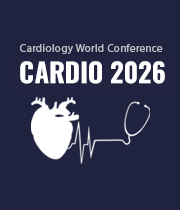Cardiac Catheterization
Cardiac catheterization, often referred to as coronary angiography, is a diagnostic procedure used to evaluate the health and function of the heart's blood vessels. During cardiac catheterization, a thin, flexible tube (catheter) is threaded through blood vessels, usually from the groin or wrist, to the coronary arteries. Contrast dye is injected through the catheter, and X-ray imaging captures detailed pictures of the coronary arteries, revealing any blockages or narrowing. This procedure is crucial in diagnosing conditions such as coronary artery disease (CAD), heart valve disorders, and congenital heart abnormalities. In addition to diagnosis, cardiac catheterization can serve a therapeutic purpose, as interventional procedures like angioplasty or stent placement can be performed during the same procedure to alleviate blockages and restore blood flow to the heart muscle.

Arthur J Siegel
Massachusetts General Hospital, United States
Sergey Suchkov
N. D. Zelinskii Institute for Organic Chemistry of the Russian Academy of Sciences, Russian Federation
Narendra Kumar
HeartbeatsZ Academy, United Kingdom
Arthur J Siegel
Massachusetts General Hospital, United States
Yong Xiao Wang
Albany Medical Center, United States
Narendra Kumar
HeartbeatsZ Academy, United Kingdom




Title : Investigating the long-term follow up of atrial septal device closures in wales and england: A comparative analysis with Major Adverse Cardiovascular Events (MACE)
Meera Gopinath, Cardiff University Medical School, United Kingdom
Title : An adult case of polysplenia syndrome associated with sinus node dysfunction
Apoorva Tripathi, Oxford University Hospitals, United Kingdom
Title : Personalized and precision medicine (PPM) as a unique healthcare model through biodesign-driven translational applications and cardiology-related healthcare marketing to secure the human healthcare and biosafety
Sergey Suchkov, N. D. Zelinskii Institute for Organic Chemistry of the Russian Academy of Sciences, Russian Federation
Title : Yasser’s criterion of inferior ST-segment discrepancy deviations in AF with aberrancy and Sgarbosa criteria - a new cardiovascular discovery and management - a case report
Yasser Mohammed Hassanain Elsayed, Egyptian Ministry of Health, Egypt
Title : Successful treatment of sinus of valsalva aneurysm
Aina Jarillo, Universidad Anahuac Mexico Norte, Mexico
Title : Metabolic and echocardiographic predictors of ventricular extrasystoles burden in non-ischemic patients
Ahmed Ahmed Mohamed Hassan, Al-Azhar Medical School, Egypt